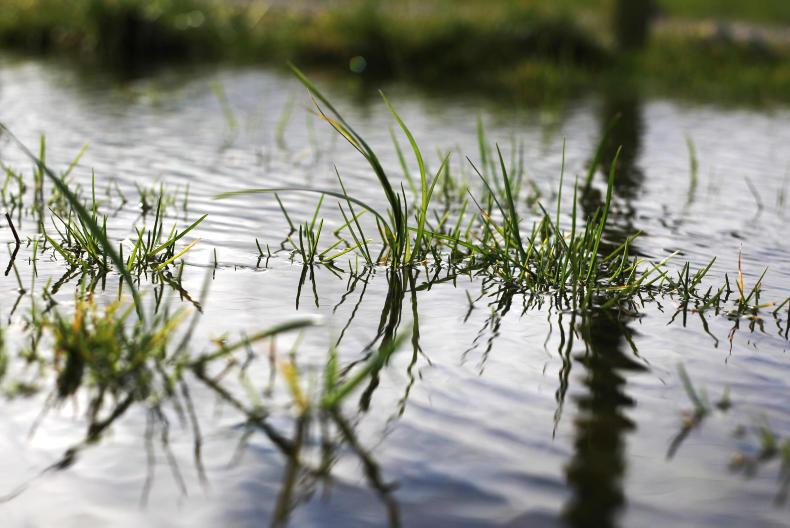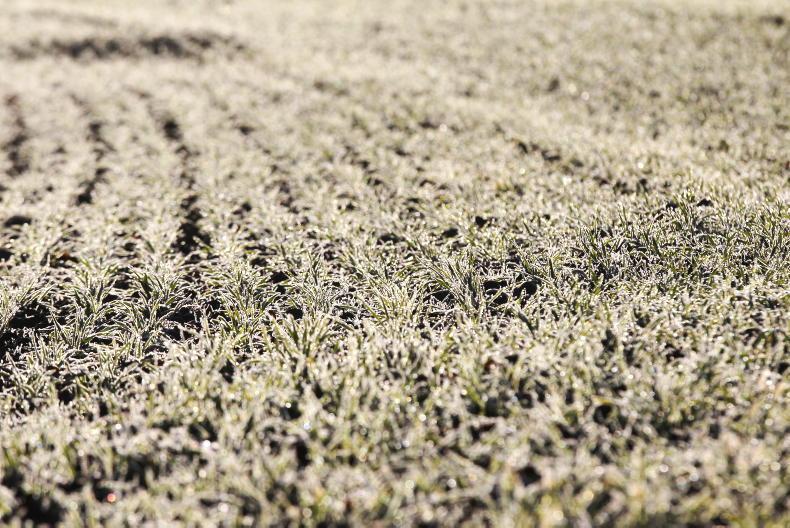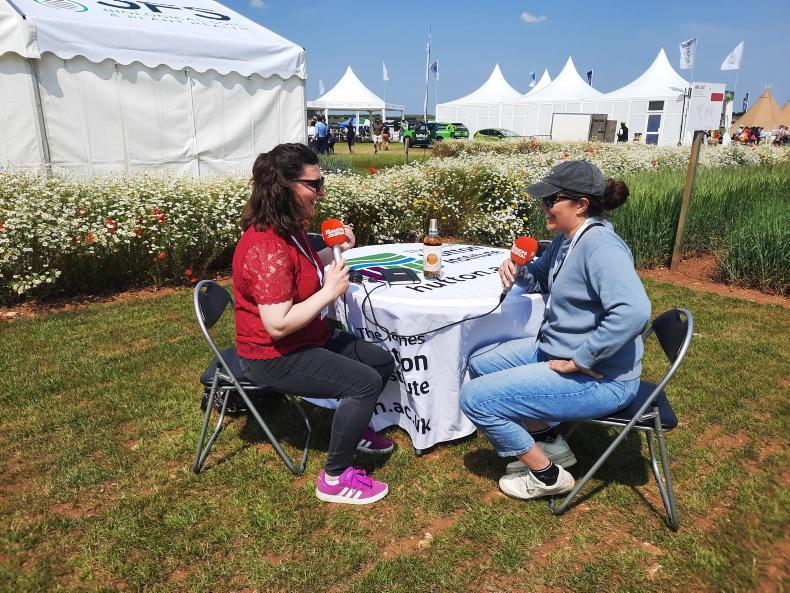Swords Co Dublin

From highs of 16°C in February to sleet and snow in March, ground work has come to a halt for now explains Ronan.
In general, however, his winter crops are looking great and, as a result of the good autumn, plant counts are very high. Winter barley was sown at the end of September and the last of the wheat was sown at the start of November.
All ground was ploughed with two five-furrow Kverneland ploughs with no. 28 boards. One plough has conventional mouldboards while his newer one has slatted boards. Ronan feels the slatted boards suits the soil conditions he works with. Around 250kg/ha of 0:10:20 was broadcast onto the seedbed before drilling with his 4m mounted Maschio Gaspardo air drill on Suffolk coulters.
This year he’s growing Cassia, Tower and Carnival winter barley and Bennington, Thorpe, Costello and Graham winter wheat. The barley was dressed with Redigo Deter as Ronan’s proximity to the Irish Sea creates a favourable environment for aphids. His barley crop also received an aphicide (Sparviero 50ml/ha) in November.

Ronan Snow applying Proline (0.35l/ha) and the boron trace element spray Amino B (3.0l/ha) to his winter oilseed rape earlier this week.
They also received an autumn application of Bulldog (3.2l/ha) and Stride DFF (0.16l/ha). Winter wheat received Naceto (0.3l/ha) with the exception of late-drilled crops which got Allister Flex (1.0L/ha) in January. Some crops may need a spring herbicide to clean up cleavers. Some crops received another 250kg/ha of 0:7:30 in February depending on soil and crop requirements. This left no tracking marks in the field.
Around 50ac is ploughed so far and he’s planning to sow Planet malting barley for Loughran Family Malt in that ground in the coming weeks. Two weeks ago his winter barley and oilseed rape received Piamon Urea (33%N+12%S) at 125kg/ha and 250kg/ha respectively.
Last month he sowed 25ac of Fanfare spring beans and plans to sow another 25ac before the end of the month. With a TGW of 643g, he used a sowing rate of 240kg/ha. The crop received a herbicide application of Nirvana (3.5l/ha) and Centium (0.1l/ha) two days after sowing.
St Johnston,
Co Donegal

Ground is wet again in Donegal thanks to two weeks of broken weather, says David. Spreading and ploughing in the last of the slurry is top of his to-do list but this will have to wait until conditions improve. Ideal sowing conditions last autumn meant he could get through work in a timely manner. Sowing was completed by 22 October with the exception of ground after potatoes which was sown by 1 November.

David Moody's Tower winter barley recieved 110kg N/ha during the good weather in February.
He’s growing the hybrid winter barley variety Bazooka and the two-row variety Tower. The seed was dressed with Kinto but he feels there was no need for Redigo Deter as BYDV pressure in the northwest is generally low. With the exception of seeding rates, both crops are managed the same.
He’s also growing the winter wheat varieties Bennington, Costello and the UK variety Shabras. He was impressed with the performance of Rockefeller in 2018 but he couldn’t secure seed for this season. He’s also growing the UK winter oat variety Mascani.
All the winter crop ground received an application of slurry before ploughing. They run two five-furrow Kverneland ploughs separately, one of which is on no. 8 boards while the other is on no. 28.
His winter barley and wheat received autumn herbicide of Firebird (0.25l/ha) and DFF (0.15L/ha) while all crops received an application of Mantrac manganese (3.0kg/ha).
There was a good window for early spring work in February, says David. Three weeks ago he applied 80kg N/ha (urea 46%) to his winter wheat and oats, while the barley received 110kg N/ha. Fertiliser applications were one month earlier this year compared to 2018. Crops on ground prone to manganese deficiency also received an application of Mantrac. Crops are now a healthy green colour.
Early in February he ploughed half of his spring crop ground. Most of this ground received slurry. He generally burns the headlands off with glyphosate (1.5l/ha) in advance of ploughing. David intends to start sowing as soon as the weather settles.
Castlemagner,
Co Cork

The weather has taken a turn for the worse in north Cork, with windy and wet conditions bringing field work to a standstill. Since the start of March, over 70mm of rain has fallen on Rob’s farm.
Winter crops are in great condition, albeit some varieties are a little too advanced and lush, Rob explains. This was helped in part by the mild winter and the excellent conditions last autumn. Sowing began on 27 September and was finished by 12 October.
Last year Rob ran three establishment systems. One-third of his winter crop area was sown by means of conventional min-till using a 4m Kockerling Ultima drill into a disced stale seedbed. One-third of the crops were established through broadcasting the seed using his Rauch Axis fertiliser spreader on to a disced stale seedbed. That ground was then shallow cultivated and rolled. This method is generally used on stronger ground. The remaining third of winter crops were sown using a John Deere 750A zero-till drill. This was his first real year trialling direct drilling.

Pictured are Rob Coleman’s cattle grazing the last of his seven species cover crop mix before spring planting.
Differences
Rob explains that, as the winter was so favourable to crop growth, there’s little visible difference in crop growth so far between the establishment methods.
This year he’s growing hybrid Quadra and Belfry winter barley which are now around GS31. He’s also growing Graham, Costello, Conros and Cellule winter wheat. Cellule, which is an early variety, is at GS31 already.
The seed wasn’t treated with Redigo Deter and he hasn’t applied an aphicide on any crops so far. He applied Firebrid (0.3l/ha) either pre- or post-emerge on his winter barley depending on the crop and Alister Flex (1.0l/ha) with biopower on the winter wheat last autumn.
All of the winter crops have received 58kg N/ha (stabilised urea 38%N + 7% S) at the end of February. Wind has proven a challenge when spreading this year. Nearly all of the cover crops are now grazed to make way for spring sowing.
“We’re in for a very busy period during the next spell of weather.”
Read more
Potato growers to lose key active for battling wireworms
€1.7m paid to farmers in fodder scheme
Irish Farmers Journal weather with Sencrop
Watch: From the tramlines returns for 2019
Swords Co Dublin

From highs of 16°C in February to sleet and snow in March, ground work has come to a halt for now explains Ronan.
In general, however, his winter crops are looking great and, as a result of the good autumn, plant counts are very high. Winter barley was sown at the end of September and the last of the wheat was sown at the start of November.
All ground was ploughed with two five-furrow Kverneland ploughs with no. 28 boards. One plough has conventional mouldboards while his newer one has slatted boards. Ronan feels the slatted boards suits the soil conditions he works with. Around 250kg/ha of 0:10:20 was broadcast onto the seedbed before drilling with his 4m mounted Maschio Gaspardo air drill on Suffolk coulters.
This year he’s growing Cassia, Tower and Carnival winter barley and Bennington, Thorpe, Costello and Graham winter wheat. The barley was dressed with Redigo Deter as Ronan’s proximity to the Irish Sea creates a favourable environment for aphids. His barley crop also received an aphicide (Sparviero 50ml/ha) in November.

Ronan Snow applying Proline (0.35l/ha) and the boron trace element spray Amino B (3.0l/ha) to his winter oilseed rape earlier this week.
They also received an autumn application of Bulldog (3.2l/ha) and Stride DFF (0.16l/ha). Winter wheat received Naceto (0.3l/ha) with the exception of late-drilled crops which got Allister Flex (1.0L/ha) in January. Some crops may need a spring herbicide to clean up cleavers. Some crops received another 250kg/ha of 0:7:30 in February depending on soil and crop requirements. This left no tracking marks in the field.
Around 50ac is ploughed so far and he’s planning to sow Planet malting barley for Loughran Family Malt in that ground in the coming weeks. Two weeks ago his winter barley and oilseed rape received Piamon Urea (33%N+12%S) at 125kg/ha and 250kg/ha respectively.
Last month he sowed 25ac of Fanfare spring beans and plans to sow another 25ac before the end of the month. With a TGW of 643g, he used a sowing rate of 240kg/ha. The crop received a herbicide application of Nirvana (3.5l/ha) and Centium (0.1l/ha) two days after sowing.
St Johnston,
Co Donegal

Ground is wet again in Donegal thanks to two weeks of broken weather, says David. Spreading and ploughing in the last of the slurry is top of his to-do list but this will have to wait until conditions improve. Ideal sowing conditions last autumn meant he could get through work in a timely manner. Sowing was completed by 22 October with the exception of ground after potatoes which was sown by 1 November.

David Moody's Tower winter barley recieved 110kg N/ha during the good weather in February.
He’s growing the hybrid winter barley variety Bazooka and the two-row variety Tower. The seed was dressed with Kinto but he feels there was no need for Redigo Deter as BYDV pressure in the northwest is generally low. With the exception of seeding rates, both crops are managed the same.
He’s also growing the winter wheat varieties Bennington, Costello and the UK variety Shabras. He was impressed with the performance of Rockefeller in 2018 but he couldn’t secure seed for this season. He’s also growing the UK winter oat variety Mascani.
All the winter crop ground received an application of slurry before ploughing. They run two five-furrow Kverneland ploughs separately, one of which is on no. 8 boards while the other is on no. 28.
His winter barley and wheat received autumn herbicide of Firebird (0.25l/ha) and DFF (0.15L/ha) while all crops received an application of Mantrac manganese (3.0kg/ha).
There was a good window for early spring work in February, says David. Three weeks ago he applied 80kg N/ha (urea 46%) to his winter wheat and oats, while the barley received 110kg N/ha. Fertiliser applications were one month earlier this year compared to 2018. Crops on ground prone to manganese deficiency also received an application of Mantrac. Crops are now a healthy green colour.
Early in February he ploughed half of his spring crop ground. Most of this ground received slurry. He generally burns the headlands off with glyphosate (1.5l/ha) in advance of ploughing. David intends to start sowing as soon as the weather settles.
Castlemagner,
Co Cork

The weather has taken a turn for the worse in north Cork, with windy and wet conditions bringing field work to a standstill. Since the start of March, over 70mm of rain has fallen on Rob’s farm.
Winter crops are in great condition, albeit some varieties are a little too advanced and lush, Rob explains. This was helped in part by the mild winter and the excellent conditions last autumn. Sowing began on 27 September and was finished by 12 October.
Last year Rob ran three establishment systems. One-third of his winter crop area was sown by means of conventional min-till using a 4m Kockerling Ultima drill into a disced stale seedbed. One-third of the crops were established through broadcasting the seed using his Rauch Axis fertiliser spreader on to a disced stale seedbed. That ground was then shallow cultivated and rolled. This method is generally used on stronger ground. The remaining third of winter crops were sown using a John Deere 750A zero-till drill. This was his first real year trialling direct drilling.

Pictured are Rob Coleman’s cattle grazing the last of his seven species cover crop mix before spring planting.
Differences
Rob explains that, as the winter was so favourable to crop growth, there’s little visible difference in crop growth so far between the establishment methods.
This year he’s growing hybrid Quadra and Belfry winter barley which are now around GS31. He’s also growing Graham, Costello, Conros and Cellule winter wheat. Cellule, which is an early variety, is at GS31 already.
The seed wasn’t treated with Redigo Deter and he hasn’t applied an aphicide on any crops so far. He applied Firebrid (0.3l/ha) either pre- or post-emerge on his winter barley depending on the crop and Alister Flex (1.0l/ha) with biopower on the winter wheat last autumn.
All of the winter crops have received 58kg N/ha (stabilised urea 38%N + 7% S) at the end of February. Wind has proven a challenge when spreading this year. Nearly all of the cover crops are now grazed to make way for spring sowing.
“We’re in for a very busy period during the next spell of weather.”
Read more
Potato growers to lose key active for battling wireworms
€1.7m paid to farmers in fodder scheme
Irish Farmers Journal weather with Sencrop
Watch: From the tramlines returns for 2019

















SHARING OPTIONS